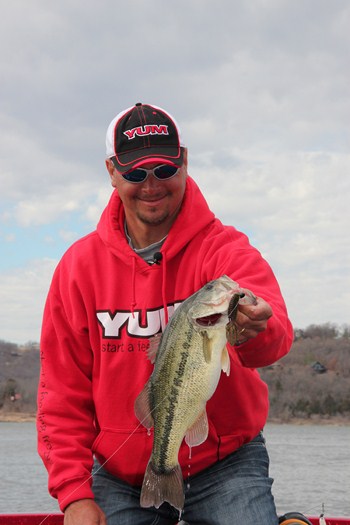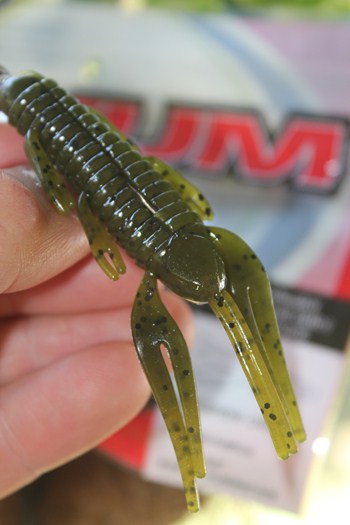Pro Advice On Flippin’ For Bass
Category: article
Sep 7th, 2012 by OutdoorsFIRST
Modified Sep 7th, 2012 at 12:00 AM
Any angler can go randomly flipping around grass or cover and catch a few bass. That should not surprise anyone, but why just settle for a few fish when you can catch more and better bass. The key to better flipping comes from knowing when to fish a quick-sinking lure or a slow-falling lure, and what to do after the lure settles to the bottom.
FLW Tour and B.A.S.S. professional angler Jason Christie always thinks flipping first when approaching a tournament. He’s so good at it, he even has a new signature series flipping rod coming out.
 |
|
| Jason Christie |
Catching better bass for Christie comes down to how fast the lure falls, or “rate of fall.”
“For me, I pick the lure and weight by the water clarity,” he said. “The clearer the water; the faster I want the lure to fall.”
Christie says that when fishing impoundments with gin clear water, like Beaver Lake and Table Rock, he wants a fast falling lure anytime the water temperature is more than 70 degrees. When water temperature gets very cold, however, he’ll begin considering a slower-sinking jig for his flipping.
The technique of flipping is done on a short line. With the reel in free spool and thumb holding the spool motionless, the angler takes the jig in his off hand (the one not holding the rod) and swings the rod to pendulum the bait toward a target in the cover, while removing the tension his thumb has been applying to the spool. The result is that the lure hits the target as quietly as possible, right in the face of the bass. Bass then strike the lure out of a feeding response or reaction strike. Christie believes that more than 75 percent of the strikes he gets while flipping are reaction strikes.
“You know, it’s hard to tell if it’s a reaction strike or a feeding strike when you flip it in and you get a bite,” he said. “In practice sometimes, I’ll flip the jig in there, get a strike and not jerk; the bass swims a couple feet and drops the lure. I think that’s a reaction bite. Then, sometimes the bass will swim and swim and swim with it. I think that’s a feeding bite.”
Christie believes that flipping a lure next to cover or structure is like putting it into their living room. You will get a reaction of some kind from the bass.
“That’s why it’s such a good technique to catch bass everywhere across the country. It can be either a feeding response or reaction strike.”
For Christie, lure selection depends on the time of the year. A large percentage of the time, Christie uses a heavy BOOYAH jig with a soft-plastic crawfish trailer, or simply the soft plastic alone. Lately, he said he’s been using the YUM Wooly Bug (Texas-rigged, sans jig). Color combinations are black-and-blue or green pumpkin.
 |
|
| Big Show Craw |
Selecting line for flipping is a challenge for every angler simply due to the massive number of styles and sizes. Christie keeps it simple. (Why not? It’s been the foundation of his success.)
“I like to use fluorocarbon fishing line when flipping; in fact that’s what I use almost always, regardless of technique. Although, I do use braid when flipping grass mats or sometimes around vegetation,” explained Christie.
Christie warns anglers considering sink-rate to think about more than just the weight of the jig or sinker. A bulky trailer like a 4½-inch YUM F2 Mighty Bug is going to fall a lot slower than the 3 ¼-inch Wooly Bug. The number of appendages sticking or shape – flat versus round — out will also make a difference in the sink rate.
The style of the lure can also make a difference. A ribbon tail worm flipped into a grass mat just doesn’t work. The tail will wrap around every little piece of grass not allowing it to fall. Good soft plastics for flipping or “punching” grass features a compact body and short appendages, such as the YUM F2 Big Show Craw.
Randomly flipping around cover or structure catches a few bass, but you’ll catch more fish by following Christie’s advice and accurately flipping the right lure. It takes practice, but when you can put a jig into a coffee cup from 10-feet away, nine out of 10 times, you’ll be ready.
Skipping Rocks, Doc(k)!
Dock after dock after dock — all day long it was the same thing. Some of the docks had one bass under them and others had two or three. It was proving to be the best way to get a quality bite, but the technique required just the right touch.
“It’s like skipping rocks, only you are using a fishing pole and a lure,” said Beaver Lake fishing guide Brad Wiegmann.
The skipping technique is all about having the right angle. When skipping light lures it’s best to use a spinning rig. Leave about 14 inches from lure to the end of the rod, open the bail and bring the rod back parallel or slight pointing toward the water. Then, simply use a sidearm cast to skip the lure to its destination. It’s skipping a heavier lure with a baitcasting rig that gives some anglers fits.
“Put the reel on free-spool and use adequate force to swing the lure parallel to the water,” Wiegmann said. “After the lure stops, take your pocket knife and cut out the tangled mess. Retie and repeat, until you have no more over-priced fluorocarbon line on your reel. Lay down this pole and grab the next, and repeat the process until all the line is removed. At this point, it’s customary to say ‘the he#% with it,’ grab a topwater rod and go throw a Zara Spook.”
Seriously, though, Wiegmann did eventually provide useful instructions on skipping with a baitcaster, once he stopped laughing at his hilarious joke. He suggests setting the brake on the reel to the level where the line comes off smoothly, and re-adjusting it each time you change lures.
“Once set, the only brake is your thumb, so use it wisely,” he said. “Side-arm similar to the way it’s done with a spinning rig, in one fluid motion. While the lure is skipping, the angler should be lightly feathering the line.”
Wiegmann noted that he uses a wacky rig in early spring around docks and walkways near where fish are staging to spawn. He switches to a white BOOYAH jig with a white grub once the shad spawn gets rolling. During summer, Wiegmann likes a Mighty Craw in watermelon red to mimic a panicked bream or bluegill.